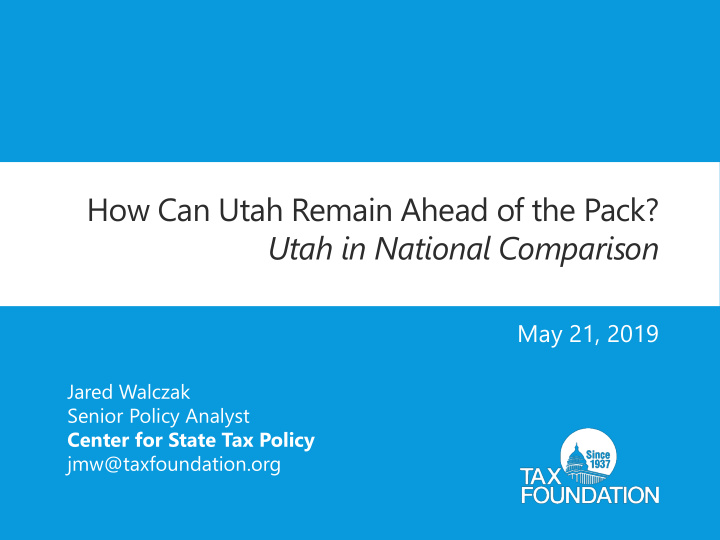



How Can Utah Remain Ahead of the Pack? Utah in National Comparison May 21, 2019 Jared Walczak Senior Policy Analyst Center for State Tax Policy jmw@taxfoundation.org
A GROWING ECONOMY GDP GROWTH, UTAH AND PEERS, 1997-2018 GDP Growth, 1997-2018 100% State Growth 90% Utah +97% 80% 70% U.S. Average +53% 60% Arizona +68% 50% Colorado +73% 40% Idaho +68% 30% Nevada +75% 20% 10% New Mexico +21% 0% Wyoming +71% U.S. Average Utah
UNIQUE FEATURES OF UTAH’S ECONOMY AND TAX CODE Earmarking of Tax Revenues • Utah earmarks 100% of individual and corporate income taxes, about 32% of sales tax • Alabama earmarks 98% of PIT, but not CIT • Massachusetts earmarks 40% of PIT and CIT • Only five other states earmark more than 10% of their PIT Density and Land Ownership • Less than a third of Utah’s land is privately owned • Three-fourths of population is concentrated in four most populous Wasatch Front counties • Eighty-five percent of taxable value concentrated in six counties
UTAH’S ERODING SALES TAX COMPARED TO U.S. AVERAGES % Change in Share of Total Tax Collections 180% 160% 140% 120% 100% 80% 60% 40% 1975 1980 1985 1990 1995 2000 2005 2010 2015 2020 U.S. Sales U.S. Income Utah Sales Utah Income
SALES & INCOME TAX FLIP PIT NOW GENERATES MORE REVENUE Income & Sales Tax Collections as a Percentage of State Income 3.5% 3.0% 2.5% 2.0% 1.5% 1.0% 0.5% 0.0% 1932 1934 1936 1938 1940 1942 1944 1946 1948 1950 1952 1954 1956 1958 1960 1962 1964 1966 1968 1970 1972 1974 1976 1978 1980 1982 1984 1986 1988 1990 1992 1994 1996 1998 2000 2002 2004 2006 2008 2010 2012 2014 2016 2018 Income Sales (unearmarked) Sales (all)
SALES TAX BASE DECLINE BARELY HALF ITS POST-WAR BREADTH Utah's Sales Tax Base as a Percentage of Personal Income 90% State Growth 80% Utah 41% 70% Arizona 37% Colorado 34% 60% Idaho 40% 50% Nevada 54% New Mexico 58% 40% Wyoming 45% 30%
BASE BROADENING SALES TAX EXPANSION IN OTHER STATES Kentucky • Personal services, including landscaping, pet care, small animal veterinary, fitness and recreational, diet and weight loss, limousine, bowling, campgrounds, extended warranties North Carolina • Services where providers already had a SUT obligation — installation, repair, maintenance, service charges Iowa • The new economy: digital goods, software as a service, ride sharing, and certain other personal services District of Columbia • Personal services linked to tangible goods or real property
WHY IT MATTERS SHOULD WE CARE ABOUT BASE EROSION? Promoting Economic Growth • Broad bases and lower rates more equitable and economically efficient • Shifts revenue toward less pro-growth PIT Ensuring Stability • Consumption taxes are economically efficient and can be stable, but current design isn’t • If sales tax is unreliable compared to earmarked taxes, can lead to poor tax policy decisions during a recession
Questions? May 21, 2019 Jared Walczak Senior Policy Analyst Center for State Tax Policy jmw@taxfoundation.org
Recommend
More recommend